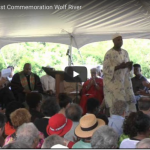GROWING DOWN INTO THE GOODNESS OF OUR GRIEF
Grief in the Life of the Lynching Sites Project
by Randall Mullins
In May 2017 a prayer service was held in Memphis to honor the centennial of the 1917 lynching of Ell Persons, an African American man who was burned alive beside the Wolf River as hundreds of white Memphians watched in support. Over 500 people attended the prayer service with an almost equal number of black and white people present. In a part of the service called the “Prayers of Lamentation and Anger” all present were invited to speak and even shout their prayers of anger and grief about the harsh history of racial violence and terrorism that has been much more of a part of our history than most people have realized.
The format was simple: anyone who felt led to was invited to speak the prayers. And to each prayer the congregation responded by simply saying in unison, “I hear you.” One African American physician shouted his anger about how many well-educated people he knew who would never speak out about racism. A white man shouted out an angry prayer about being raised in an environment steeped in racism that never allowed him to see African Americans for the full human beings that they were. There was a sense of deep listening in the room. For many it was the most sacred and moving part of the service. It went on and on and on and would have gone longer had not the leaders of the prayer called it to a close out of respect for other parts and people in the service.
Even though lament and anger are very much a part of the Hebrew, Christian and other scriptures, it has usually been give low priority in public worship in American society. In this setting the prayers served as a haunting and beautiful reminder of how important it is that all of us in America learn how to grieve together about the parts of our history that are shameful, brutal and which have moved us as a national community far away from the deepest, truest values of what it means to be a human being.
One of the essentials for racial healing in America is that black and white Americans learn how and be willing to grieve together. Much that is admirable can be done without feeling the grief that most of us in this conversation will acknowledge that we carry about the violent truths of our history, but the way into the levels of love and community that we are longing for will not be given to us until we are willing to join hands and wade into the rivers of grief out of which will flow the creative energies that heal at the deepest levels of who we are and reveal to us more clearly the work that still needs to be done. With that “father of waters,” the Mississippi, that flows through our town, we are so well placed on our planet to visit the river of grief regularly. Could the Mississippi River be a central metaphor for all the tears that America has never shed over its past? And that age-old hymn, “Shall We Gather at the River?” is another invitation to the healing that “flows from the heart of God.”
I do not believe that it is possible for white Americans to ever come close to fully understand what it is like to be black in America. But this reality need not cut us off from the ancient and sacred invitation (and command) to love one another.
I don’t know exactly when I became conscious of it for the first time, but I know that at least since my teenage years I have felt a deep longing for a closeness, for intimate friendships with African Americans in my life. Most of those friendships have been cordial and mutually respectful, but there always seemed to be some areas of separation between us that did not seem to be present in my close friendships with white friends. The longing has never gone away.
Many among us, black and white, have testified to how deeply black and white Americans need one another. During my Memphis growing up years in the 1950s and 60s, demonizing years of segregation, white Memphians worked overtime to maintain the separations of the past well beyond the change in laws that made it unlawful. Yet even in the days of more severe segregation, many felt the longing that could not be satisfied.
Now that I am nearing the age of 70, Memphis is racially integrated in most of the areas of its institutional life, including local government, a few public schools, some religious gatherings, hospitals, the media, business and more. Many feel proud of the progress we have made in living together compared to how we lived in the 1960s and before.
Yet there is one important dimension of life that seems to remain mostly segregated. I cannot document this fully with hard evidence, but it is my impression that the vast majority of black Memphians only occasionally have white friends visit in their homes and that this is also true of white Memphians having black Memphians visit in their homes. I know that this is not the preference of most white friends I know. From this I am inclined to presume that it remains true for most that natural, close black-white friendships are still very much the exception rather than the rule.
Why is this the case, especially when it seems clear that this is not the preference of most people of either group? I have no easy answer to this. But I would like to suggest that one way, perhaps one requirement, for moving closer to this possibility, is that we seek together the situations and settings that can take us into the river of grief together.
How do we do this? I cannot offer many suggestions. But I do believe that when we become ready to make this difficult journey that a way, and even many ways, will be open to us. The prayers in the service noted above provide one possibility.
In the life of the Lynching Sites Project we have experienced moments when the work of naming and telling the stories together of those who were brutally lynched in the past seemed to take us forward a step or two toward that place of liberating grief.
It is my experience that facing this grief is always going to be much more difficult for white Americans than for back Americans. Black Americans have lived with it since the 1600s. Terri Freeman, President of the National Civil Rights museum, once said in a speech in Memphis, “being black in America is a full-time job.” The recurring observation that “white people just don’t get it,” is always going to be true to one extent or another in this country whose original sin, and whose very blood, is soaked in racism. It is in the air that we breathe. No one escapes it. Few white Americans move very far out of the unconsciousness of it into which we all are born.
And yet there is that river. There is that place that wants to welcome us and show us how to flow within it into news places of awareness and hope. Getting to that river may take us through miles of thick briars and brambles. We are likely to have some scratches and sores on our bodies before we arrive at the river bank. We are not used to such discomforting journeys.
Carla Peacher-Ryan’s longer story of her April visit to the new National Memorial for Peace and Justice is included elsewhere in this blog. But her final paragraph belongs here to conclude this essay also:
Saturday, in the lobby, I thought I saw Anthony Ray Hinton, a black man who spent 30 years on death row, for a crime he didn’t commit, and who was released 16 years after Bryan Stevenson first took his case. I just wanted to thank him for his life and story, but I started crying and couldn’t stop. He reached his arms out and held me and said “It’s going to be alright.’ What is wrong with this picture? 63 year old white corporate lawyer with most every advantage in life being comforted by a black man who spent 30 years on death row. Just Mercy, indeed.










































